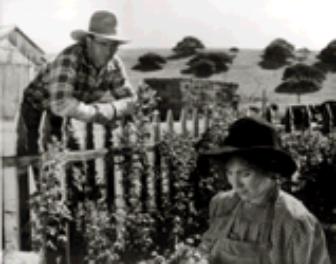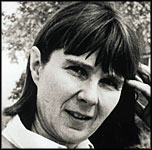|
Text 1
The Chrysanthemums
About the author:
American novelist, story writer, playwright, and essayist(1902-1968),
Steinbeck received the Nobel Prize for Literature in 1962.
He is best remembered for THE GRAPES OF WRATH (1939), a novel
widely considered to be a 20th-century classic. The epic about
the migration of the Joad family, driven from its bit of land
in Oklahoma to California, led to a wide debate about the hard lot of migrant
laborers, and helped to put an agricultural reform into effect.
California, led to a wide debate about the hard lot of migrant
laborers, and helped to put an agricultural reform into effect.
John Steinbeck was born in Salinas, California. His native
region of Monterey Bay was later the setting for most of his
fiction. Steinbeck's father was a county treasurer and mother
a teacher. He attended the local high school and studied marine
biology at Stanford University between 1920 and 1926, but
did not take a degree. During these early years several of
his poems and short stories appeared in university publications.
After working for a short time as a laborer and reporter in
New York City for the American, Steinbeck returned to California.
While writing, Steinbeck worked as a manual laborer. He was
apprenticehood-carrier, apprentice painter, caretaker of an
estate, surveyor, and fruit-picker. While working as a watchman
of a house in the High Sierra Steinbeck wrote his first book,
CUP OF GOLD (1929). In Pacific Grove in the early 1930s Steinbeck
met Edward Ricketts, a marine biologist, whose views on the
interdependence of all life deeply influenced Steinbeck's
thinking. In the novel TO A GOD UNKNOWN (1933) he mingled Rickett's ideas with Jungian concepts and themes, which had
been made familiar by the mythologist Joseph Campbell.
Steinbeck's first three novels went unnoticed, but in 1935
appeared his humorous tale of pleasure-loving Mexican-Americans,
TORTILLA FLAT, which brought him wider recognition, but the
theme of the book─the story of King Arthur and the forming
of the Round Table─remained well hidden from the critics.
IN DUBIOUS BATTLE (1936) was a strike novel set in the California
apple country.
OF MICE AND MEN (1937), a story of shattered dreams, became
Steinbeck's first big success. In the same year appeared also
THE RED PONY which is among Steinbeck's finest works. The
events take place on the Tiflin ranch in the Salinas Valley,
California.
For The Grapes of
Wrath Steinbeck traveled around California
migrant camps in 1936. When the book appeared it was attacked
by Oklahoma's State Representative Lyle Boren who characterized
it as "a lie, a black, infernal creation of twisted,
distorted mind. Later, when Steinbeck received his Nobel Prize,
the Swedish Academy called it simply "an epic chronicle."
The Exodus story of Okies on their way to an uncertain future
in California ends with a scene in which Rose of Sharon, who
has just delivered a stillborn child, suckles a starving man
with her breast.
Fleeing publicity followed by the success of
The Grapes of Wrath, Steinbeck went to Mexico in 1940 to film the documentary
Forgotten Village. During WW II Steinbeck served as a war
correspondent for the New York Herald Tribune in Great Britain
and the Mediterranean area. He wrote such government propaganda
as the novel THE MOON IS DOWN (1942), which depicted resistance
movement in a small town occupied by the Nazis.
In 1943 Steinbeck moved to New York City, his home for the
rest of his life. His twelve-year marriage to Carol Henning
ended in 1942. Next year he married the singer Gwyndolyn Conger;
they had two sons, Thom and John. However, the marriage was
unhappy and they were divorced in 1949. Steinbeck spent summers
at Sag Harbor and travelled in Europe. Steinbeck's postwar
works include THE PEARL (1947), a symbolic tale of a Mexican
fisherman, and A RUSSIAN JOURNAL (1948), an account of the
author's journey to the Soviet Union with the photographer
Robert Capa.
In 1950 Steinbeck married Elaine Scott. His son John was hospitalized
for codeine addiction at age seven, and he also had much problems
in later years with drugs and alcohol. He died in 1991.
About the story:
The Chrysanthemums was published in 1937, gen erally regarded
to be one of Steinbeck's finest short stories. Some critics argue
that it is the protagonist, Elisa Allen who makes The Chrysanthemums
a great short story. Others argue Steinbeck's well-crafted
plot and skillful use of symbol make the story great. So pay
attention to the plot, symbol and characterization of the
story. Besides, the narration merits special attention. It
is written in the third-person objective point of view—the
narrative remaining outside of the minds of the characters.
Much of the ambiguity and the appeal of Elisa Allen come from
the readers' never knowing precisely what she is thinking. erally regarded
to be one of Steinbeck's finest short stories. Some critics argue
that it is the protagonist, Elisa Allen who makes The Chrysanthemums
a great short story. Others argue Steinbeck's well-crafted
plot and skillful use of symbol make the story great. So pay
attention to the plot, symbol and characterization of the
story. Besides, the narration merits special attention. It
is written in the third-person objective point of view—the
narrative remaining outside of the minds of the characters.
Much of the ambiguity and the appeal of Elisa Allen come from
the readers' never knowing precisely what she is thinking.
Language notes:
1. Behind
her stood the neat white farmhouse with red geraniums close-banked
around it as high as the windows.
(她身后是整洁的白色农舍,红色的天竺葵紧紧地簇拥着,有窗户那么高。)
Banked: heaped around.
e.g. The snow was banked in humps at the roadside.
2. Her
terrier fingers destroyed such pests before they could get
started.
(如果真有的话,她那犀利无比的手指也会在这些害虫逃跑之前就将它们消灭。)
Terrier: a small dog of breed, here used to emphasize
the tenacity and eagerness of Elisa.
e.g. She would fight like a terrier for every penny.
3. He
climbed over the singletree, steadying himself with a hand
on the burro's white rump.
(他爬到马车前的横木上,一只手放在毛驴白色的屁股上,让自己坐稳。)
Singletree: (Northeastern U.S.) the pivoted horizontal crossbar to which the harness traces of a draft animal are attached and which is in turn attached to a vehicle or an
implement. Also called: swingletree, whiffletree, whippletree.
Burro: a small donkey, especially one used as
a pack animal in the west of America.
4. She
shook herself free and looked about to hear whether anyone
had been listening.
(她摇摇头让自己清醒过来,四处看看是不是有人在听。)
Shook herself free: shook
herself to
get free from her meditation and obsession.
Text 2
How Soon Can I Leave?
About the author:
Novelist, children's writer and playwright Susan (Elizabeth)
Hill was born in Scarborough, England, on 5 February 1942. She
was educated at Scarborough Convent School and at grammar school
in Coventry, before reading English at King's College, London,
graduating in 1963 and becoming a Fellow in 1978. Her first
novel, The Enclosure, was published in 1961 when she was still
a student. She worked as a freelance journalist between 1963
and 1968, publishing her third novel, Gentleman and Ladies, in
1968. She became a Fellow of the Royal Society of Literature
in 1972 and was a presenter of BBC Radio 4's 'Bookshelf' from
1986 to 1987. In 1996 she started her own publishing company,
Long Barn Books, editing and publishing a quarterly literary
journal, Books and Company, in 1998.
educated at Scarborough Convent School and at grammar school
in Coventry, before reading English at King's College, London,
graduating in 1963 and becoming a Fellow in 1978. Her first
novel, The Enclosure, was published in 1961 when she was still
a student. She worked as a freelance journalist between 1963
and 1968, publishing her third novel, Gentleman and Ladies, in
1968. She became a Fellow of the Royal Society of Literature
in 1972 and was a presenter of BBC Radio 4's 'Bookshelf' from
1986 to 1987. In 1996 she started her own publishing company,
Long Barn Books, editing and publishing a quarterly literary
journal, Books and Company, in 1998.
She won a Somerset Maugham Award for I'm the King of the
Castle (1970); the Whitbread Novel Award for The Bird of Night
(1972); and the Mail on Sunday/John Llewellyn Rhys Prize for
The Albatross (1971), a collection of short stories. Her other
novels include Strange Meeting (1971), set during the First
World War, In the Springtime of the Year (1974), Air and
Angels (1991), and most recently, The Service of Clouds
(1998). The Woman in Black (1983), a Victorian ghost story,
was successfully adapted for stage and television and Mrs de
Winter (1993) is a sequel to Daphne du Maurier's Rebecca.
Susan Hill is also the author of two volumes of memoir, The
Magic Apple Tree: A Country Year (1982), about her life in
rural Oxfordshire during the 1970s, and Family (1989), in
which she writes about her early life in Scarborough. Her
books for children include The Glass Angels (1991), Beware,
Beware (1993) and King of Kings (1993). She has also written
radio plays, a number of books of non-fiction and has edited
several anthologies of short stories including two volumes of
The Penguin Book of Modern Women's Short Stories, published in
1991 and 1997. Her most recent book, The Boy Who Taught the
Beekeeper to Read, a new collection of short stories, is
forthcoming in 2003.
Susan Hill is married to the Shakespeare scholar Professor
Stanley Wells with whom she lives in a farmhouse in the north
Cotswolds.
Language notes:
1. Miss
Roscommon, the older and stouter of the two, concealed her
fear of life behind frank reference to babies and lavatories
and the sexing of day-old chicks.
(罗丝康门小姐年纪大一点,身材也壮些。她直率地谈论婴儿、厕所、如何鉴别刚出生一天的雏鸡雌雄,以此来掩饰对生活的恐惧。)
Sex:determine the sex of.
e.g. sexing fish.
2. Miss
Bartlett, who was only forty, cultivated shyness and self-effacement,
out which arose her way of leaving muttered sentences to trail
off into air, unfinished.
(芭特莱特小姐只有40岁,文雅,害羞,谦逊。说话声音很低,还没说完就听不见了。)
Muttered sentences: here means that her voice was low and
barely audible.
Trail off: (of the voice of a speaker) fade gradually before
stopping.
e.g. Her voice trailed off from embarrassment and nervousness.
3. She
was too timid to take any so definite a step, for, by establishing
herself in a shop, with her name written up on a board outside,
was she not established herself in the minds of others, as
a shopkeeper?
(她太怯懦,不会作出任何这样的决断。因为开一个商店,把自己的名字写在外面的招牌上,这难道不是让人认为自己是个小店主吗?)
Establish: achieve recognition or acceptance
for someone in a particular capacity.
e.g. He had established himself as a film star.
4. Also,
by having her name written up on that board, she felt that
she would somehow be committing herself to Mountsea, and by
doing that, finally abandoning all her hopes of a future in
some other places.
(而且,她觉得,一旦把名字写在招牌上,就像把自己和蒙特西连在了一起,就彻底放弃了她所有将来生活在别处的梦想。)
Commit oneself to: resolve to remain in
a long-term relationship with.
e.g. She didn't love him enough to commit herself to him.
5.
Miss Bartlett accepted the soup
and a chair close to the fire and an electric blanket for
her bed, thereby setting the seal on the future pattern of
their relationship.
(芭特莱特小姐接受了韭葱汤,一张靠火的椅子和铺在床上的电热毯,同时也确定了两人未来生活的模式。)
Set the seal on: provide or constitute the final
confirmatory or conclusive factor.
e.g. The rain set the seal on his depression.
TOP |
